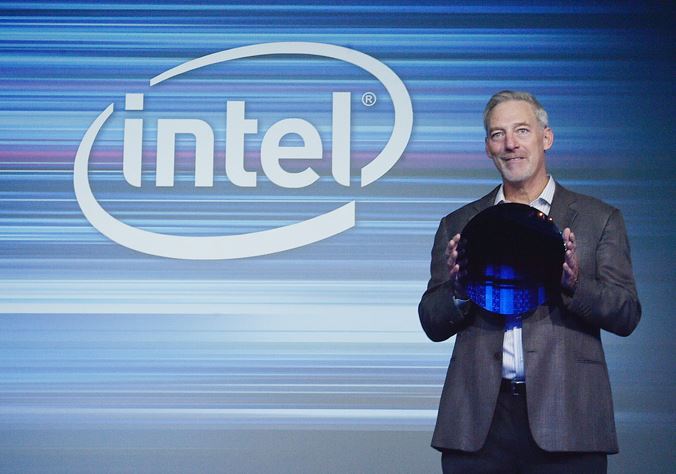Intel Displays 10nm Cannon Lake Wafer, First Signs Of PCIe 4.0, $1 Billion AI Investment
Intel held its Technology and Manufacturing Day (TMD) event earlier this year, and it shared a range of updates on its process technology and plans for the future. The company held a similar event in Beijing on September 19, and though most of the information fell into familiar territory, the company also displayed a 10nm Cannon Lake wafer and finally announced a product with PCIe 4.0.
Intel displayed a laptop bearing a 10nm Cannon Lake processor earlier this year, but it displayed a 10nm Cannon Lake wafer at TMD and unveiled details of its new "Falcon Mesa" FPGA. Interestingly, Intel's 10nm Falcon Mesa comes bearing the PCIe 4.0 interface. We recently caught up with the PCI-SIG at Hot Chips, and while the organization indicated that PCIe 4.0 is finally almost ready for prime time, it could not share expected deployment timelines for major vendors (such as Intel and AMD).
Although the Falcon Mesa FPGA isn't destined for the desktop PC in any fashion, it is encouraging to see Intel bring the interface to the 10nm platform. It could also imply we might see it debut on 10nm desktop processors. We've waited seven years for the new interface, but we might have to wait for yet another, as Intel's 10nm products are widely predicted to make their debut next year.
Intel's new FPGA also wields 112 GBps serial transceiver links and uses Intel's EMIB (Embedded Multi-Die Interconnect) that we've covered in depth. They also feature many of the familiar features of Altera-derived FPGAs, such as HBM and the HyperFlex architecture.
Intel also displayed a 10nm wafer with ARM Cortex-A75 CPU cores that the company claims can perform in excess of 3GHz. The 10nm ARM cores are the result of an agreement between ARM and Intel's Custom Foundry as the company attempts to compete with other major fabs for a piece of the broader custom market. Intel also continued the custom foundry parade with a 22FFL (a low power FinFET process) wafer, which is geared for mobile applications. Intel claims the 22FFL process powers CPUs up to 2GHz but with 100x lower leakage. Intel’s custom foundry business is a great idea for utilizing its manufacturing capabilities to generate another source of revenue, but competition is stiff with established custom foundry competitors like Global Foundries and TSMC.
Intel charted a course to a more diversified portfolio when it announced a massive restructuring effort last year. Intel is diversifying into data center adjacencies and other new areas, such as IoT and automated driving, as it reduces its reliance on its bread and butter desktop PC market, which continues to decline steadily. Even though all of these new focus areas feature profoundly different silicon use-cases, AI is one of the technologies that touch all of them.
As such, Intel announced that it is making strategic investments in a broad spate of partnerships and R&D initiatives. Intel is spending $1 billion through its Intel Capital fund with startups like Mighty AI, Data Robot, and Lumiata. Intel has already invested heavily in AI with recent acquisitions, such as Mobileye, Nervana, Altera, and Movidius. Intel also has a solution in its Nervana AI portfolio for nearly every segment with Xeons, Xeon Phi, FPGAs, and ASICs on tap, but much of the latest work comes on the software enablement front. Many of Intel's new investments center on AI-as-a-service providers, which will fuel hardware sales in the future.
Get Tom's Hardware's best news and in-depth reviews, straight to your inbox.

Paul Alcorn is the Editor-in-Chief for Tom's Hardware US. He also writes news and reviews on CPUs, storage, and enterprise hardware.
-
JamesSneed Is that a stock 300nm wafer with nothing on it or did they put a reflective layer on top? Maybe i'm a bit to skeptical but I don't feel like there is anything on that wafer.Reply -
markivmariaj That AUTOPLAY Ad is so irritating, I'm going to stop opening TomsHardware articles. It's blatant, repetitive and annoying.Reply -
RobertGru So you are telling us about Intel's Technology and Manufacturing Day held in March now? Can I buy you a calendar?Reply -
TJ Hooker Reply
Apparently there is more than one TMD per year. There was one in March, but there's another going on today.20190452 said:So you are telling us about Intel's Technology and Manufacturing Day held in March now? Can I buy you a calendar?
https://newsroom.intel.com/news/intel-technology-manufacturing-day-china/ -
toesis use flash-block and adblock to stop auto-play ads i have never seen this ad ppl are talking aboutReply -
berezini Toms hardware doesnt want people to know about adblockplus and helpful element hide addon. they already banned my other account for telling people about it.Reply -
bit_user They should just add a subscription option. I'd pay a couple $ per month for faster loading pages w/ no ads.Reply -
jephill1 That's not a finished wafer, they are copper colored like the one Krzanich showed Trump awhile back. But it's all show, these are fake 'pretty wafers' that have limited layers. It's stupid.Reply
